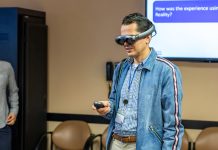
New technology is outpacing workers’ skill sets, exposing employers to new and persistent skill gaps in the workplace.
While data shows 84 percent of employees a looking to their employers to keep pace with changing skillsets in their industry, companies continue to rely on outdated one-size-fits-all training programs. Current learning and development programs focus on traditional course-based training models that fail to align with current trends.
In order to create a successful learning and development program, employers should focus on creating a learning environment that encourages employees to take charge of their own growth. Employers can leverage various forms of training, from workshops and seminars to interpersonal approaches like mentorship programs.
As a people leader, Agata Zasada, SVP of People and Culture at ZayZoon, values employee autonomy and takes an unconventional approach to learning and development.
Q&A with Agata Zasada:
How can organizations strike the right balance between giving employees freedom to guide their own learning and ensuring that development aligns with business objectives?
In order for learning and development to be successful, it has to be a balanced, collaborative journey led by the employee and supported by the employer. Historically, HR teams and business leaders have taken a “parental” role in learning and development, where they may have designated career paths with rigid structures that employees follow. But true growth happens when employees are the drivers behind their development.
Organizations can find the right balance by encouraging employees to define how they want to grow and then determine what roads and resources they have to get them there. When employees can detail what they want, what they need, and what outcomes they’re looking for, employers can clearly offer access to the right opportunities and experiences. For example, if an employee is interested in managing a team, their manager can identify a cross-functional project where they can take the lead, providing support along the way so they can begin developing leadership skills through hands-on experience. With this approach, employees can be in charge of their own growth, with managers and HR being the guardrails while advancing broader business goals.
Smaller organizations find this easier because employees understand the business and its direct impact. Owners or leaders can tie that learning directly to what they hope to get from that learning, which may be expertise, shoring up knowledge or competencies, or trying new things. Larger organizations tend to try to professionalize this into a program, which is when the switch from employee-led to employer-led tends to happen, all with great intent.
How can L&D programs be designed to support both short-term performance and long-term career growth, especially in rapidly evolving industries?
Learning and development programs designed with flexibility, collaboration, and hands-on experience can help employees and their employers address both short and long-term growth goals. Development programs that focus on traditional one-size-fits-all training can’t keep pace with changing skill demands across different industries, whether it’s technical skills like AI literacy or soft, evolving skills like adaptability.
Instead of leaning on just formal learning, HR leaders and management should create agile, applied learning opportunities that align with employee interests. By collaborating with employees to create tailored learning paths, organizations can give them the opportunity to take on new challenges, sometimes failing, and refine their skills through experience. This, in turn, creates an environment that blends short-term opportunities to build and practice skills with long-term access to experiences to create broader employee development.
Consider that the notion that all learning needs to tie to company performance or impact can be harmful. Employees are on a journey in life and their career, and the company that they work for is just a period of time. If we invest in the person and not the employee, that person will likely be more engaged, stay longer, or self-select at the right time.
How can organizations create a learning culture where employees feel empowered to take initiative without fear of failure or judgment?
Creating a culture where employees feel empowered to be the drivers of their own growth starts by developing an environment of trust. Business leadership, HR, and middle managers need to have meaningful conversations with employees about their future careers. People know what they are missing in their development and workplace experience to get to the next point of their career, and managers and HR teams must prove they are open to hearing and closing those gaps as much as possible.
Instead of trying to dispel fear of failure, they can focus on positioning mistakes as opportunities to “fail forward” and emphasize the supportive guardrails employees will have along their learning path. Conversations focused on employee growth should highlight what employees want, why they need it, and how it aligns with broader organizational objectives or career aspirations. Through candid discussions, organizations set a strong foundation to prove they are genuinely committed to individual employees.
Most people learn from mistakes versus success; applying that to your learning and culture is important. These mistakes or failures can be treated differently depending on the severity of the impact. Some forward-thinking companies celebrate failures and share root causes and major insights broadly to minimize similar failures. Others may simply commit that employees will never experience disciplinary action if the failure or mistake was unintentional.
What does autonomy in learning look like in practice, particularly for SMBs that may not have extensive resources to support large-scale training programs?
Autonomy in learning doesn’t have to mean big budgets or large-scale formal programs, especially for resource-strapped businesses. While I think it’s important for businesses to have a budget for learning and development opportunities, it’s equally important to create a hands-on learning environment, even if it’s on a small scale.
The key is to frame learning across three focal areas: experience, competency, and knowledge. With experience, employees can learn through real-time projects that develop and test skills, while broadening employee exposure to new challenges. Competence is developed through practice, where employees can repeat and refine core competencies consistently. Knowledge is the business acumen; when employees gain a better understanding of their sector, the “why” behind different decisions, and how it aligns with business goals. When you help transform learning in this way, whether it’s providing tailored projects, mentorship opportunities, or setting time aside for self-directed learning, employees gain a holistic view of learning and development.
Practical things to think through, can you put aside a budget, even a small one, that people can use for learning? Expect some level of non-compliance and take the benefit of those who use it correctly. For example, can each person expense up to $40 in books for development? Sure, someone may expense a non-fiction versus a development book, but think about all the employees who have learned something and are intrinsically trying to get better. That behaviour doesn’t just get bucketed to their own development, it absolutely spills out to the organization.
What advice would you give to other people leaders trying to shift toward a more employee-driven development model, especially in fast-paced or resource-constrained environments?
HR leaders know that employees want to do good work, create an impact, be recognized, and they especially want to grow. When you empower and support employees with the right tools, trust, and autonomy, they’ll want to be accountable not only for themselves but also for their teams. Learning and development should not be micromanaged, where managers and HR have to approve everything, creating unnecessary bottlenecks. Instead, people leaders should be facilitators, helping to make informed decisions about their growth, creating tailored learning paths on a person-by-person basis. Letting go of the need to be consulted or approving learning is something that will feel new and even difficult to HR leaders, who tend to be accountable for the budget and even protecting it for future years. The need to calculate ROI needs to be put on the shelf for now. By leaning on hands-on experiences, supplemented by existing learning materials, HR teams create new momentum for agile development that employees become more invested in and engaged with.




